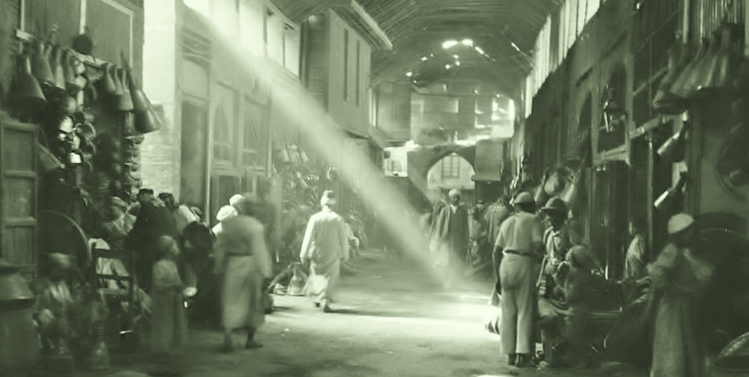The Boy, Baba-Jiddu and Souk Al-Safafeer
Dr. Basel Al-Aswad,
April 2023
Baba – Jiddu:
He can’t recall when and how he came up with this name “Baba-Jiddu” for his maternal grandfather Abdul-Ahad Nemo, nor could any of the grownups in the first years of his life. In Arabic, Baba stands for “dad” and Jiddu for “grandpa”. Maybe because they all lived in the same house and he saw Jiddu as much as Baba he concluded he had two dads, naming the older accordingly. More important was the special affinity and bond between the lively boy and the quiet, kind hearted head of the household, in the Big House in the Sa’adoon neighborhood of Baghdad.
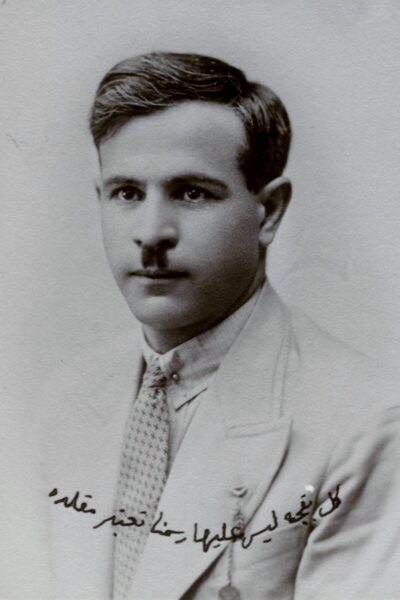
A. Nemo (Jiddu), late 1920s, proprietary used on merchandise. (Arabic script: Any package without our picture is considered counterfeit)
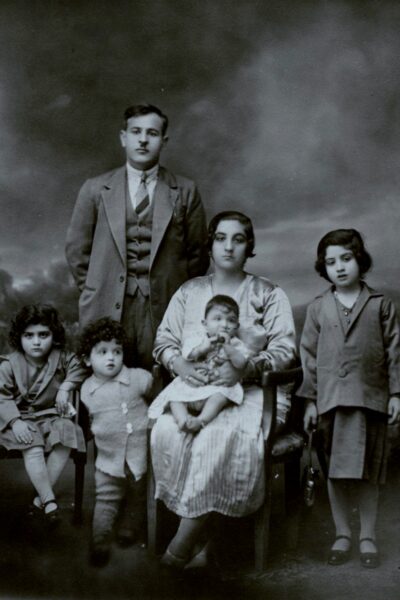
A. Nemo family, Baghdad, 1931.
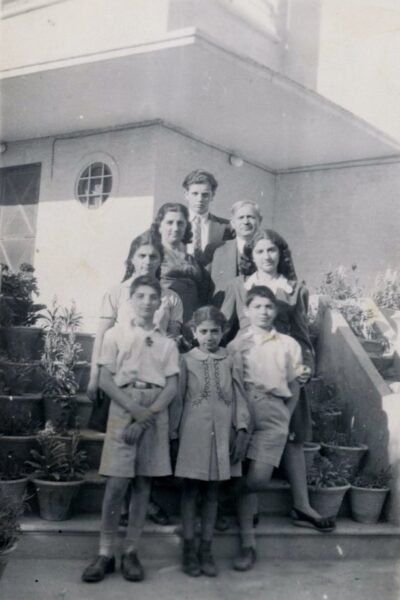
A. Nemo family in front of the Big House in Baghdad,1945.
The Boy:
The twelve room mansion with a coach house and garage was built in 1943 to accommodate the patriarch’s large family and the continuous flow of guests arriving from Mosul, their ancestral city in the north. The boy, first born to the eldest daughter, arrived later in 1946 and stayed there until he was six years old when his parents moved to their own place, a few blocks away.
Later, after grandpa was gone, the boy, himself a Jiddu now, had plenty of clear, distinctive and colorful memories of their times together. The early summer mornings rushing down from the rooftop where he slept, down to the front porch helping Jiddu, making tea with the samovar. Escaping the brutal hot weather by joining grandpa in his afternoon siestas in the “sirdab,” the sunken cool room of the big house.
Then in the evening accompanying him to the cafe’s on Sa’adoun street, with men playing backgammon and dominoes, drinking tea and yelling at each other.
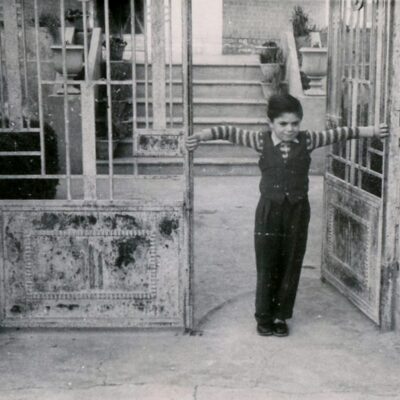
Boy (author) at the gate of the Big House in Baghdad, 1952.
The most exciting were their trips to Jiddu’s business, the khan (inn) in Souk Al-Safafeer (Copper Market).
Souk Al-Safafeer:
Join me, the present Jiddu, on a trip down memory lane as we travel by car from the big house, around the corner to Sa’adoon’s White Palace, up Nidhal Street, to Tahrir Square (Bab Al-Sharji area), then north on the most famous of all, Al-Rasheed Street continuing just past the Central Bank close to Marjan Mosque. The sounds of hammers beating on copper, percussionists in a symphony, herald our arrival at this ancient busy market. The cacophony of sounds competing with kaleidoscopic visuals mesmerizes us just as it captured the boy’s attention way back then. We have a hard time navigating the narrow winding streets with open shops and stalls protruding from them, making it seem like an obstacle course. Just like generations before them, the workers in these shops manufacture and shape the various products, from the original metal to household necessities, mainly pots and pans and a few larger ones for industrial purposes, using large hammers, anvils and even torches to fuse and shape the raw metal. They are artisans, shaping their ware towards perfection and beauty, both creative and functional. Suddenly, we sense different aromas as we traverse a more sedate section of the market, selling other goods, from grains to fabric. The alleys get even narrower and finally we’re there, the Al-Bahrani Khan.

Souk Al-Safafeer, Baghdad, 1932. Wikipedia.
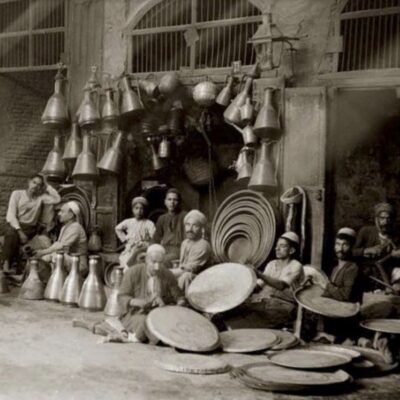
Coppersmiths at Souk Al-Safafeer, Baghdad, 1932. Probably Matson Collection.
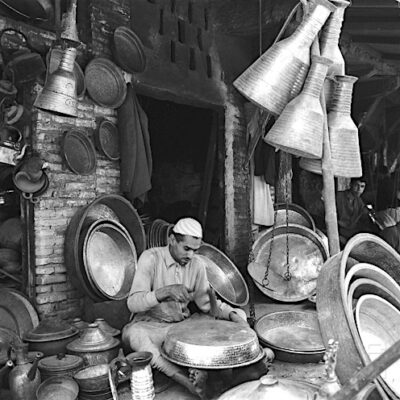
Coppersmith at Souk Al-Safafeer, Baghdad, 1962. photographer Latif Al-Ani. Wikipedia

Coppersmith at Souk Al-Safafeer, Baghdad, 1970s.
An imposing two story structure in the heart of the souk, with a large worn out wooden double door: it leads into an open courtyard, with side open spaces for storage, but we take a sharp turn right and go up a winding stairway to the second floor. A large open room filled with bales of paper ready for conversion to cigarettes, piled up in heaps confronts us. We continue along an inner balcony overlooking the ground floor, bathed in light escaping from the permeable ceiling and pass smaller offices occupied by other tenants, lawyers and professionals to end up in the master office, my grandfathers. A comfortable couch beckons the tired visitor, as well as several chairs and a large main desk, but for the boy the main attraction was the immense imposing solid safe, a mini bank of sorts for those times with Jiddu being the merchant and banker. Soon the whole place starts buzzing with action, muscular men carrying the large bales up the stairs, fellow merchants and visitors conducting business transactions and depositing documents and cash in the safe, others just there to chat, all registered in a motion-picture-like reel in my Hippocampus somewhere in my brain’s temporal lobe.
These were the early 1950s, but the enterprise started in the 20s in Mosul as grandpa and his two brothers started a wholesale merchandise business of a variety of imported products mainly tea and tobacco.
In 1931 he expanded his business and moved his family to Baghdad, and thrived there in that location for over 3 decades before retiring in the early 60s.
Souk Al-Safafeer was a distinctive Baghdadi cultural institution in addition to its commercial utility that had lasted for centuries, maybe as old as the city itself. The memories above were from its heydays in the 1940s and 50s. Currently what’s left of it is but a shadow of the glorious days of yore.
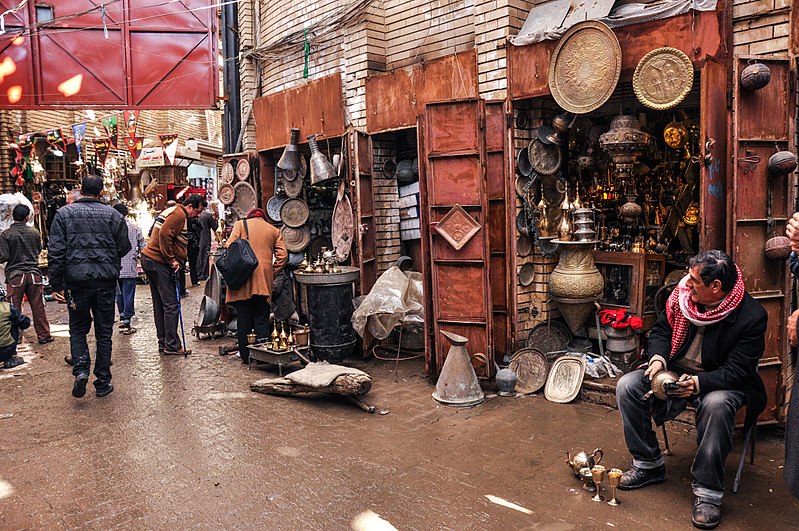
Souk Al-Safafeer, Baghdad, 2017. Wikipedia.
Bibliography
- Nemo family images courtesy of Dr. Basel Al-Aswad.
Cover Image
Iraq Market from Matson Collection, 1932 (similar to Souk Al-Safafeer), Library of Congress via pingnews.
————————————————————————————————————————————————————————————————————————————————————————————————————
About Dr. Basel Al-Aswad,
Dr. Basel Al-Aswad is an orthopedic surgeon in Chicago, USA. Born in Baghdad in 1946, he graduated from Al Ta’sissiyah Elementary School in 1957 and Baghdad College High School in 1962. After finishing University of Baghdad Medical School and Army Reserves, Basel immigrated to the United States in 1970 and pursued his specialty training in orthopedic surgery. Now semi-retired, his passions range from archiving his family’s history, to lecturing on mindfulness, and writing a column in Escape Into Life https://www.escapeintolife.com, an online literary & arts magazine founded by his late son, Chris. He enjoys spending time with his large Iraqi family, especially his two young granddaughters. Interested in further stories re: the boy, the house, the neighborhood in Baghdad of early 1950s go to Via Basel: Little Man in the Big House | Escape Into Life and previous columns.

